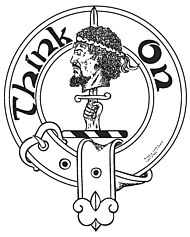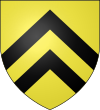Clan MacLellan
| Clan MacLellan | |||
|---|---|---|---|
| MacGille Fhaolain – (son of a servant of Saint Fillan) | |||
 | |||
| Motto | Think On | ||
| Profile | |||
| Region | Lowlands | ||
 | |||
| Clan MacLellan has no chief, and is an armigerous clan | |||
| The 10th Lord Kirkcudbright | |||
| Historic seat | MacLellan's Castle | ||
| Last Chief | The Rt. Hon. Camden Gray Maclellan | ||
| Died | 1832 | ||
| |||
| |||
| |||
The Clan MacLellan is a Lowland Scottish clan.[1] The clan does not currently have a chief therefore it is considered an Armigerous clan.[1]
History[]
Origins[]
The name MacLellan is Scottish Gaelic in origin.[1] It is derived from MacGille Fholain which means son of the servant of St Fillan, and appears originally in the fourteenth century as 'MacGillolane'.[1] St Fillan was a missionary of the old church of Celtic Christianity.[1] There is also a village in Perthshire named after him and the name Fillan is derived from faelchu which means wolf in the Celtic language.[1] Although the clan were based in Galloway,[1] the first of the name to enter the records was Duncan MacLellan who appears on a charter of Alexander II of Scotland in 1217.[1] The marked similarity between the ancient arms of the MacLellans and the Medieval Mormaers of Strathearn (two chevronels on a plain shield) adds to the possibility that the clan may have originated in the Southern Highlands, before attaining land in Galloway in the thirteenth century.[2] The leadership of the clan can be traced back to Cane or Cahan MacGillolane, a knight in the service of the Balliol lords of Galloway in the later thirteenth century, whose son Gilbert served as Bishop of Sodor and Man in the reign of Robert I.[3]
Wars of Scottish Independence[]
During the Wars of Scottish Independence, most of Galloway's leading families backed the Baliol, rather than Bruce claim to the throne of Scotland and, hence, fought against the English in the early years of conflict before gradual submission to Edward I after the collapse of the first phase of resistance under William Wallace. The MacGillolane kindred followed this trajectory, and most of the sons of Cane MacGillolane had chosen to submit to the Plantagenet crown by the end of 1298: their names appearing in various Gaelic or Norman forms as "Fitz Cane" or "Mac Cane" in the English diplomatic records. "John de Bombie" whose lands became the centre of clan territory held out for the longest period, and clan tradition places him among the close followers of Sir William Wallace when he left Kirkcudbright for France after the defeat at the Battle of Falkirk (1298).[1] Blind Harry's The Wallace cites a 'Cleland' as part of the gathering that ventured out from Scottish shores in search of foreign support.[4]
15th century and clan conflicts[]
After maintaining forlorn support for the house of Baliol into the mid-fourteenth century, the MacLellans were ushered back into service of the Scottish crown under David II. So successful was their reintegration that during the early 15th century there were reputedly no fewer than fourteen knights in Galloway of the name MacLellan.[1] One of these, Sir Alexander MacLellan was cited by the sixteenth-century historian David Hume of Godscroft (drawing on the monastic Book of Pluscarden) as the Scotsman who slew the duke of Clarence while fighting in French service at the Battle of Baugé in 1421. In 1451 Sir Patrick Maclellan of Bombie, Sheriff of Galloway clashed repeatedly with William Douglas, 8th Earl of Douglas over outbreaks of lawlessness committed by the earl's retainers. These conflicts culminated when MacLellan rejected Douglas's appeal to join an aristocratic conspiracy against King James II. Douglas captured the sheriff and imprisoned him in Threave Castle. MacLellan's uncle, Sir Andrew Gray of Foulis held high royal office and sent his son, Sir Patrick Gray, into Galloway, with letters from the crown ordering Douglas to release his prisoner. However Douglas had MacLellan murdered when presented with the royal warrant, whilst he entertained his guest at dinner.[1] Patrick Gray escaped from the castle, and his vow of revenge was realised in brutal form when he stood at the forefront of the loyalist nobles who assassinated the earl of Douglas in front of the king at Stirling in February 1452. Local tradition holds that the MacLellans themselves used the celebrated Scottish cannon Mons Meg to batter down Threave Castle in retribution for the murder of their chief.[1]
As the feud escalated n the following generation, the MacLellan estates were forfeited after repeated raids on the Kirkcudbrightshire lands of the Clan Douglas.[1] However James II restored the family to their lands when Sir William MacLellan, son of Sir Patrick captured the leader of a band of gypsies who had been terrorizing the district.[1] William carried the head of the brigand to the king on the point of his sword.[1] The story is one explanation for the MacLellan clan crest, however a Moors' head has also been considered as an allusion to the Crusades.[1] These events established the MacLellans as a bastion of support for the Stewart crown in a region prone to lawlessness and aristocratic powerplay. Their affiliation was confirmed in 1488 when Sir Thomas MacLellan supported James III against the rebellion that ended in the death of the king after the Battle of Sauchieburn. With most of the magnates of the south-west and the borders fighting in support of the insurrection, MacLellan's residence was burned to the ground after the monarch's defeat.[5]
16th century and Anglo-Scottish Wars[]
The family suffered severely during the Anglo-Scottish Wars of the reigns of James IV and James V. Sir William Maclellan of Bombie was knighted by King James IV of Scotland but was killed at the Battle of Flodden in 1513 fighting for the king.[1] William's son, Thomas, was killed in Edinburgh at the door of St Giles' Cathedral by Gordon of Lochinvar in 1526.[1] Thomas's younger brother, William Maclellan of Nunton presided over the family as Tutor of Bombie while Thomas's son was in infancy, and mobilised the successful defence of Kirkcudbright against English besiegers in 1547. The younger Thomas Maclellan was killed in the same year at the Battle of Pinkie Cleugh. In the following generation, Sir Thomas Maclellan of Bombie fought for Mary, Queen of Scots at the battle of Langside, and prospered subsequently under her son James VI.[6] He served as Gentleman of the Bedchamber to the king, and as provost of Kirkcudbright, constructing Maclellan's Castle as a fashionable gentleman's residence overseeing the town.
17th century and Civil War[]

arms— argent two chevrons Sable;
crest— a naked cubit arm, supporting upon the point of a sword, erect, a moor's head, all ppr.;
supporters— Dexter: a chevalier in complete armour, holding in his right hand a baton, all ppr.; Sinister: a horse argent furnished gules;
Mottoes— Think on; and Superba frango
Sir Robert MacLellan, was a courtier both to James VI and Charles I.[1] In 1633 he was raised to the peerage as Lord Kirkcudbright.[1] During the Scottish Civil War the third Lord was such a zealous royalist that he incurred enormous debts in the king’s cause.[1] As a result, the estates were completely ruined.[1]
18th to 19th centuries[]
There were two claimants to the chief's title at the beginning of the 18th century and the dispute was finally settled by the House of Lords in 1761.[1] However the title became dormant again when the ninth Lord died in Bruges in 1832.[1]
Castle[]
MacLellan's Castle, found in Kirkcudbright in south-west Scotland was the seat of the chief of Clan MacLellan. The castle's beginnings lie in the Reformation of 1560 which led to the abandonment of the Convent of Greyfriars which had stood on the site now occupied by the castle since 1449.
Hebridean MacLellans[]
There are concentrations of MacLellans found in the Western Isles on Uist. The surname borne by these MacLellans is represented by the Gaelic Mac Gille Fhialain, instead of the usual form Mac Gille Fhaolain borne by other MacLellans.[8][note 1] The Uist MacLellans were once known collectively as Na Faolanaich. The North Uist MacLellans are also known as Clann Iain Mhóir, after Iain Mór (John Mor MacLellan), a seventeenth-century ancestor. It is possible that this family descends from South Uist MacLellans who migrated to North Uist.[8]
See also[]
- Black Morrow, traditional story of the crest used in MacLellan heraldry.
- Maure, the head of a Moor used in heraldry.
Notes[]
References[]
- ^ a b c d e f g h i j k l m n o p q r s t u v w x Way, George and Squire, Romily. Collins Scottish Clan & Family Encyclopedia. (Foreword by The Rt Hon. The Earl of Elgin KT, Convenor, The Standing Council of Scottish Chiefs). Published in 1994. Pages 424 - 425.
- ^ "History Kirkcudbright". heritagearchaeology.com.au. Retrieved 12 December 2021.
- ^ Andrew McCulloch, Galloway. A Land Apart (2000)
- ^ Blind Harry, The Wallace (1661 edn.), p. 219.
- ^ Jane Dawson, Scotland Re-formed, 1488-1587 (2007)
- ^ Sir Andrew Agnew, The Hereditary Sheriffs of Galloway (1893)
- ^ A General and Heraldic Dictionary of the Peerage and Baronetage of the British Empire; p.44; By John Burke; Published by H. Colburn and R. Bentley, 1832; link
- ^ a b Matheson, W (1983). "Notes on North Uist Families". Transactions of the Gaelic Society of Inverness. 52: 318–372 – via Google Books.
- ^ MacLellan, A (1997). Stories From South Uist. Edinburgh: Birlinn. ISBN 1-874744-26-2.
- ^ Mac an Tàilleir, I (2016). "Ainmean Pearsanta" (DOCX). Retrieved 21 December 2018 – via Sabhal Mòr Ostaig.
External links[]
- Clan MacLellan
- Armigerous clans
- Gaels
- Scottish clans
